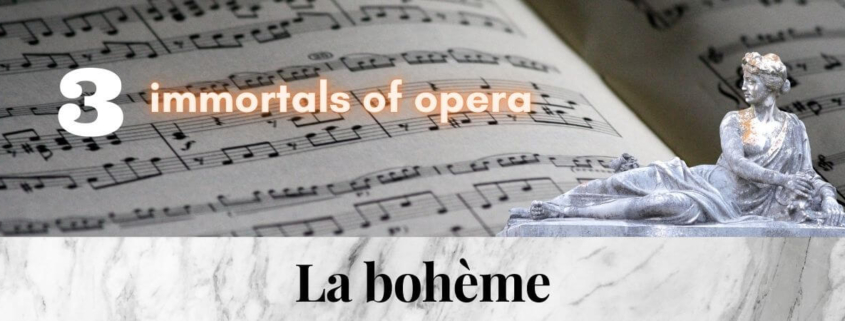This opera offers Puccini at his best. Every detail of this work is masterfully composed and the melodies are passionate and tender. The opera is one of the most performed in the entire operatic repertoire.
Mimi shows up with a candle in her hand
As Rodolfo lights Mimi’s candle he feels her cold hands. The aria “Che gelida manina” begins pianissimo and dolcissimo, and the first part ends with a beautiful rallentando as Rodolfo points to the luminous moon shimmering romantically into the room (“e qui la luna”). In the second part, Rodolfo describes himself as a poet and a poor artist, and in the third part he sings of the two beautiful eyes of Mimi that have appeared for his delight. At this point we hear the love motif for the first time:
Infinitely romantic occurs the famous final sequence with the high C (“Ma il furto non m’accora, poiché, poichè v’ha preso stanza, la speranza”).
Many experts consider Pavarotti the best Rodolfo in recording history. In the words of Kesting: “Outstandingly, also and especially in terms of performance, Pavarotti sets the scene as Rodolfo under Karajan. It is one of the rare vocal portraits that makes the character visible. In no other recording – La fille du Régiment aside – has he sung more freely and loosely, in none with a richer palette of color.”
Che gelida manina – Pavarotti/Karajan
Mi chiamano Mimi – the second great aria of Bohème
In this aria Puccini portrays Mimi at the beginning with very simple means. Thus, at her first appearance, her text remains surprisingly unpoetic at first (“my name is Mimi…once my name was Lucia; industrious I am, and cook my own food”) and is composed in simple harmonies. Mimi recognizes her feelings for Rodolfo. Suddenly the text becomes poetic (“Ma quando vien lo sgelo” – “Yet it begins to thaw…”) and the music opens to Mimi’s motif, which we will hear many times, one of Puccini’s great musical inspirations:
This piece is what Puccini called a “pezzo forte” – a number that he knew would make an impact
Naturally, this aria has been recorded by many great singers. Reason enough to select three great recordings for you.
Let’s start with perhaps the greatest, that of Renata Tebaldi. Tebaldi was not a great actress. This was partly due to polio at the age of three, which caused a certain immobility. All the more she had to rely on her vocal abilities. And they were outstanding. “In the rich unfolding of the treble, she has no equal after the war.” (Kesting). Toscanini is said to have even called her voice (the accuracy of the statement is disputed) “angelic.”
Mi chiamano Mimi – Tebaldi
“O soave fanciulla” – a great love duet
Under the magic of the moonlight shimmering in the penthouse, the two confess their love to each other.
A beautiful love duet unfolds. See “O soave fanciulla” in the filmed version with Renata Tebaldi and Jussi Björling, opera can no longer be more emotional.
O soave fanciulla – Björling / Tebaldi









Leave a Reply
Want to join the discussion?Feel free to contribute!